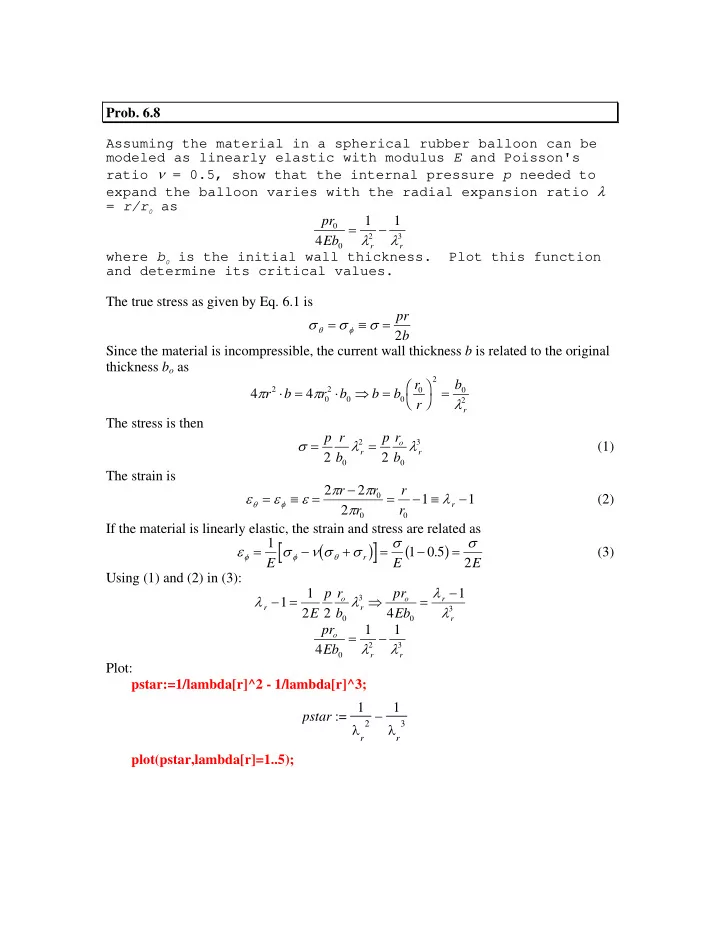

Prob. 6.8 Assuming the material in a spherical rubber balloon can be modeled as linearly elastic with modulus E and Poisson's ratio ν = 0.5, show that the internal pressure p needed to expand the balloon varies with the radial expansion ratio λ = r/r 0 as pr 1 1 = − 0 λ λ 2 3 4 Eb 0 r r where b 0 is the initial wall thickness. Plot this function and determine its critical values. The true stress as given by Eq. 6.1 is = pr σ = σ ≡ σ 2 θ φ b Since the material is incompressible, the current wall thickness b is related to the original thickness b o as = F H I 2 r b K = π ⋅ = π ⋅ ⇒ 2 2 0 0 4 r b 4 r b b b λ 0 0 0 2 r r The stress is then p r p r 3 σ = λ = λ 2 o (1) r r 2 b 2 b 0 0 The strain is π − π 2 r 2 r r ε = ε ≡ ε = = − ≡ λ − 0 1 1 (2) φ θ π r 2 r r 0 0 If the material is linearly elastic, the strain and stress are related as a f b g σ σ 1 ε = σ − ν σ + σ = − = 1 0 5 . (3) φ φ θ r E E 2 E Using (1) and (2) in (3): λ − 1 p r pr 1 λ − = λ ⇒ = 3 o o r 1 λ r r 3 2 E 2 b 4 Eb 0 0 r pr 1 1 = − o λ λ 2 3 4 Eb 0 r r Plot: pstar:=1/lambda[r]^2 - 1/lambda[r]^3; 1 1 − pstar := 2 3 λ r λ r plot(pstar,lambda[r]=1..5);
* p 0.14 0.12 0.1 0.08 0.06 0.04 0.02 0 1 1 2 3 4 5 λ r Determine λ r at maximum pressure: 'lambda[r,max]'=solve(diff(pstar,lambda[r])=0,lambda[r]); 3 λ , = 2 r max The maximum normalized pressure is Digits:=4;'pstar[max]'=evalf(subs(lambda[r]=3/2,pstar)); = pstar max .1481 This maximum is commonly experienced as a yield-like phenomenon in blowing up a balloon. However, its origin is geometrical and not a function of the material. Prob. 6.9 Repeat the previous problem, but using the given constitutive relation for rubber: F I E G 1 J σ = λ − 2 H K λ λ t x x 2 2 3 x y The circumfrential extension ratio is: π 2 r λ = λ = = λ r φ θ π 2 r 0 This is also both λ x and λ y in the given relation. From Eq. (1) of the previous solution we can write F I G J p r E 1 σ = λ = λ − 3 H 2 K o λ r r 4 2 b 3 0 F I r G J pr 1 1 1 = − H K o λ λ 7 4 b E 6 0 r r
Plotting this along with the prevous result: pstar1:= 1/lambda[r]^2 - 1/lambda[r]^3; pstar2:= (1/6)*(1/lambda[r] - 1/lambda[r]^7); plot({pstar1,pstar2},lambda[r]=1..5); 0.14 linear elastic 0.12 0.1 0.08 0.06 rubber elastic 0.04 0.02 1 1 2 3 4 5 λ r Extension at maximum pressure: Digits:=4;'lambda[r,max]'=fsolve(diff(pstar2,lambda[r])=0,lambda[r]); λ , = -1.383 r max The maximum normalized pressure: 'pstar[max]'=evalf(subs(lambda[r]=1.383,pstar2)); = pstar max .1033
Recommend
More recommend